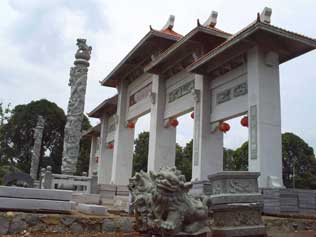Chinese Garden at Taman Mini: Jakarta West Java
 In the scorching heat of East Jakarta last Wednesday, construction workers unloaded carved solid marble blocks, placing them under an unfinished 24-meter wide Chinese gate. Several meters from the workers, children picnicked beside a two meter high stone statue of a lion, while their parents took pictures of the gate. The whole scene would not be unusual in a housing complex in any Jakarta suburb. Anything remotely Chinese seems to sell like hotcakes these days as Anissa S. Febrina explains.
In the scorching heat of East Jakarta last Wednesday, construction workers unloaded carved solid marble blocks, placing them under an unfinished 24-meter wide Chinese gate. Several meters from the workers, children picnicked beside a two meter high stone statue of a lion, while their parents took pictures of the gate. The whole scene would not be unusual in a housing complex in any Jakarta suburb. Anything remotely Chinese seems to sell like hotcakes these days as Anissa S. Febrina explains.
But this Chinese garden project — which has been running for little over five months — is inside the Taman Mini Indonesia Indah amusement park. And it is something exceptional.
The project is worth noting in its scale and the sums of money put into it. But more important is how the garden project reflects the country’s decision, post-Soeharto, to embrace Chinese culture.
“Every culture in Indonesia is represented by individual gardens in Taman Mini. We felt that it was about time that this window into Indonesia represented the Chinese culture,” Indonesian Tionghoa Group (PSMTI) chairman Tedy Jusuf said last week.
After getting the nod from Taman Mini owner Yayasan Harapan Kita, which granted PSMTI an approximately one hectare lot at the back of the park, the group footed the bill for the groundbreaking and first phase of construction.
With plans boasting a mini Imperial Palace, a pagoda, a man -made lake and several other replicas of Chinese buildings, the project has needed some Rp 70 billion in investment.
Currently, visitors to the park can only see a wide gate bearing the sign “Indonesian Tionghoa Cultural Garden“, two tall columns carved with Chinese mythical figures and two giant lion statues. Several marble outdoor seats and smaller lion statues sit waiting to be placed somewhere permanent.
“We have only come up with around 10 percent of the investment required for the project. But, I believe that since the project is for a good cause, we’ll be able to collect more donations,” Tedy said.
The group also hopes the project, which is scheduled for completion by 2008, will attract more visitors to the 32-year old amusement park.
Visiting Chinese-themed amusement parks is nothing new for Jakartans.
Since 1999, when the government began trying to combat the anti-Chinese sentiment fostered under the New Order regime, private developers have been introducing their own versions of Little China.
New housing complexes, with their imported facades, have opened Chinese-styled food courts and bazaars, such as Kampung Cina in Cibubur, East Jakarta.
But building a Chinese garden inside Taman Mini, the pet project of former first lady Tien Soeharto, is altogether more interesting. The late wife of Indonesia’s ruler for 32 years first mulled the idea of building a miniature Indonesia in 1970.
Five years later, the 145-hectare amusement park was opened to the public, boasting several museums and displays of the culture of the country’s then 26 provinces.
Chinese culture was most definitely not on the original park’s list. Soeharto’s regime forbade Indonesian Chinese from celebrating the lunar new year and other public displays of their culture.
The fact that a Chinese garden is welcomed in today’s Taman Mini shows the park is keeping up to date with the country’s political and cultural trends.
Despite claims that Taman Mini is a true representation of this culturally diverse country, the park that Soeharto built is more a symbol of the Java-centered Indonesia of his rule.
But, ethnocentrism aside, the park does serve as a public space in the capital.
These days, the park — which will celebrate its 32nd anniversary on April 20 — still boasts an average of 30,000 visitors on weekends and public holidays.
The park is still the best place for elementary students to explore traditional houses from all over the country. The park is also well known for its museums, including the gigantic inverted cone of the Purna Bhakti Pertiwi museum, which is filled with souvenirs from foreign countries.
The park is still a place where families and friends can roll out their plastic mats, unpack their picnic baskets next to the man-made lake and have lunch together.
Unfortunately, the park has seen very little in the way of upgrades. Taman Mini might have seemed sophisticated by 1970s standards, but it could do with a makeover today.
Anissa S. Febrina